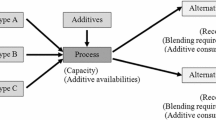Abstract
Increasing global competition, quality standards, environmental awareness and decreasing ore prices impose new challenges to mineral industries. Therefore, the extraction of mineral resources requires careful design and scheduling. In this research, simulated annealing (SA) is recommended to solve a mine production scheduling problem. First of all, in situ mineral characteristics of a deposit are simulated by sequential Gaussian simulation, and averaging the simulated characteristics within specified block volumes creates a three-dimensional block model. This model is used to determine optimal pit limits. A linear programming (LP) scheme is used to identify all blocks that can be included in the blend without violating the content requirements. The Lerchs–Grosmann algorithm using the blocks identified by the LP program determines optimal pit limits. All blocks that lie outside of the optimal pit limit are removed from the system and the blocks within the optimal pit are submitted to the production scheduling algorithm. Production scheduling optimization is carried out in two stages: Lagrangean parameterization, resulting in an initial sub-optimal solution, and multi-objective SA, improving the sub-optimal schedule further. The approach is demonstrated on a Western Australian iron ore body.




Similar content being viewed by others
References
Journel AG and Alabert F (1989). Non-Gaussian data expansion in the earth science. Terra Nova 1: 123–134.
Deutsch CV and Journel AG (1998). GSLIB: Geostatistical Software Library and User's Guide. Oxford University Press: Oxford.
Lerchs H and Grossman IF (1965). Optimum design of open-pit mines. CIM Trans 58: 47–54.
Srinivasan S and Piotto P (1996). Pit-blend optimisation—a case study in iron ore. The AusIMM Proc 1: 39–42.
Underwood R and Tolwinski B (1998). A mathematical programming viewpoint for solving the ultimate pit problem. Eur J Opl Res 107: 96–107.
Hochbaum DS and Chen A (2000). Performance analysis and best implementations of old and new algorithms for the open-pit mining problem. Opns Res 48: 894–914.
Hochbaum DS (2001). A new–old algorithm for minimum-cut and maximum-flow in closure graphs. Networks: Int J 37(4): 171–193.
Gershon ME (1987). An open-pit production scheduler: algorithm and implementation. Mining Eng 39: 793–796.
Wang Q and Sevim H (1992). Enhanced production planning in open pit mining through intelligent dynamic search. Institute of Mining Metallurgy (ed). 23 APCOM (Application of Computers and Operations Research in the Mineral Industries) Symposium Proceedings. Institute of Mining Metallurgy, London, pp 461–471.
Winkler BM and Griffin P (1998). Mine production scheduling with linear programming—development of a practical tool. Institute of Mining Metallurgy (ed). 27 APCOM (Application of Computers and Operations Research in the Mineral Industries) Symposium Proceedings. Institute of Mining Metallurgy, London, pp 673–679.
Onur AH and Dowd PA (1993). Open-pit optimization—part 2: production scheduling optimization and inclusion of roadways. Trans Inst Mining Metallurgy (Section: A Mining Industry) 102: A105–A113.
Tolwinski B and Underwood R (1996). A scheduling algorithm for open pit mines. IMA J Math Appl Business Ind 7: 247–270.
Smith ML (1999). Optimizing inventory stockpiles and mine production: an application of separable and goal programming to phosphate mining using AMPL/Cplex. CIM Bull May: 61–64.
Caccetta L and Hill SP (2003). An application of branch and cut to open pit mine scheduling. J Global Optim 27: 349–365.
Laarhoven PJM and Aarts EHL (1987). Simulated Annealing: Theory and Applications. Reidel: Dordecht.
Aarts EHL and Korst JHM (1989). Simulated Annealing and Boltzmann Machines. Wiley: New York.
Eglese RW (1990). Simulated annealing: a tool for operational research. Eur J Opl Res 46: 271–281.
Kirkpatrick S, Gelatt CD and Vecchi MP (1983). Optimization by simulated annealing. Science 220: 671–680.
Elevli B, Dagdelen K and Salamon M (1990). Single time period production scheduling of open pit. Mining Trans 103: 1888–1893.
Sefarini P (1994). Simulated annealing for multi objective optimization problems. In: Tzeng GH, Wang HF, Wen UP and Yu PL (eds). Proceedings of the Tenth International Conference on Multiple Criteria Decision Making. Springer-Verlag, Berlin, pp 283–293.
Czyzak P and Jaszkiewicz A (1998). Pareto simulated annealing—a metaheuristic technique for multipleobjective combinatorial optimization. J Multi-Criteria Decision Anal 7: 34–47.
Ulungu EL, Teghem J and Ost Ch (1998). Efficiency of interactive multi-objective simulated annealing through a case study. J Opl Res Soc 49: 1044–1050.
Suppapitnarm A, Seffen KA, Parks GT and Clarkson PJ (2000). Simulated annealing: an alternative approach to true multiobjective optimization. Eng Optim 33: 59–85.
Johnson DS, Aragon CR, McGeoch LA and Schevon C (1989). Optimization by annealing: an experimental evaluation; part I, graph partitioning. Opns Res 37: 865–892.
Lundy M and Mees A (1986). Convergence of an annealing algorithm. Math Programm 34: 111–124.
Dowsland K (1993). Some experiments with simulated annealing techniques for packing problem. Eur J Opns Res 68: 389–399.
Author information
Authors and Affiliations
Corresponding author
Rights and permissions
About this article
Cite this article
Kumral, M., Dowd, P. A simulated annealing approach to mine production scheduling. J Oper Res Soc 56, 922–930 (2005). https://doi.org/10.1057/palgrave.jors.2601902
Received:
Accepted:
Published:
Issue Date:
DOI: https://doi.org/10.1057/palgrave.jors.2601902



